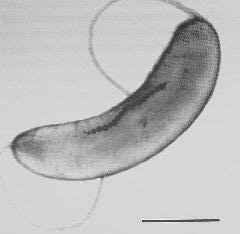magnetotactic bacteria

The magnetotatic bacterium Magnetospirillum magnetotacticum.
Magnetotactic bacteria are bacteria that effectively have internal compasses and are able to orient themselves with respect to a magnetic field. Magnetotactic bacteria (MTB) orient and migrate along the geomagnetic field towards favorable habitats, a behavior known as magnetotaxis. They were first reported in 1975 by microbiologist Richard P. Blakemore. Subsequent studies have shown that MTB are a morphologically diverse group of aquatic microorganisms that live in both freshwater and marine environments ranging from aerobic to anoxic.
All MTB contain magnetosomes, which are nanometer-sized, magnetic, mineral crystals enclosed in a membrane. In most cases the magnetosomes are arranged in a chain or chains, apparently fixed within the cell adjacent to the plasma membrane. In many MTB strains, the magnetosome crystals are magnetite, characterized by a narrow size distribution and uniform, species-specific, crystal habits. In MTB from marine, sulfidic environments, the magnetosome crystals are the iron-sulfide mineral greigite (Fe3S4), which is isostructural with magnetite and is also ferrimagnetically ordered at room temperature.


